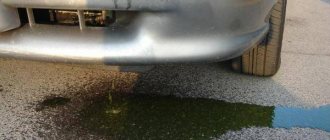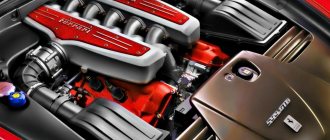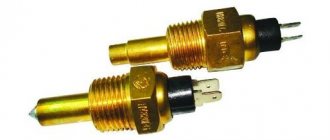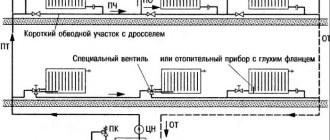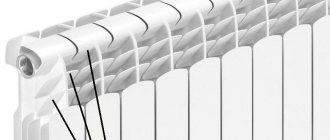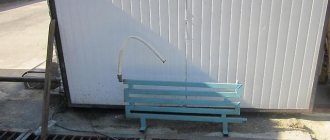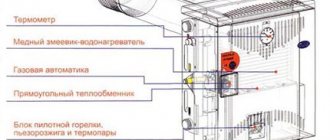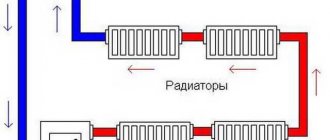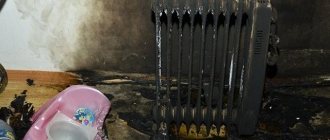When a car engine is running, each cylinder constantly increases its temperature due to the detonation of the supplied fuel. If the temperature is not lowered, constant micro-explosions will lead to the motor reaching a critical temperature, exceeding which will destroy the power unit.
To prevent this, a car engine cooling system is installed. In this article we will look at all the basic information about this node.
Cooling system: what is it
Many car enthusiasts are wondering - cooling system: what is it?
The cooling system is designed to cool engine parts that are heated as a result of its operation. On modern cars, the cooling system, in addition to its main function, performs a number of other functions, including:
- heating the air in the heating, ventilation and air conditioning system;
- cooling the oil in the lubrication system;
- cooling of exhaust gases in the exhaust gas recirculation system;
- air cooling in the turbocharging system;
- cooling the working fluid in an automatic transmission.
Depending on the cooling method, the following types of cooling systems are distinguished: liquid (closed type), air (open type) and combined. In a liquid cooling system, heat is removed from the heated parts of the engine by a flow of liquid. The air system uses air flow for cooling. The combined system combines liquid and air systems.
Radiator Maintenance
Considering what a radiator is, we need to talk about the principles of its maintenance. In some car models, cleaning the radiator will be easy. In some brands of cars, this process will require large financial costs. Therefore, it is easier to buy a new radiator right away.
In summer, the car's cooling system requires special attention. It is during this period of time that there is a high probability of contamination with dust, fluff, etc. In addition to external factors, the radiator can accumulate an oil film. It is this that leads to a decrease in air circulation, as well as a decrease in the cooling capacity of the system.
Knowing the features of the radiator of your car, you will be able to make the right decision in the process of its maintenance. Over time, any cooling system will require repairs. To prevent this from happening for as long as possible, it is necessary to properly configure the cooling system in the summer and protect it from contamination.
Purpose and varieties
Heat removal is far from the only purpose of an engine cooling system. She is additionally responsible for performing a number of other tasks:
- heating the air mass for heating the vehicle interior;
- reducing the waiting time required to bring the engine to operating temperature;
- reducing the temperature of lubricants used for internal combustion engines;
- if recirculation is used, the temperature of the exhaust gases from the internal combustion engine decreases;
- if there is an automatic transmission, the lubricant located inside is cooled.
The design of the engine cooling system directly depends on its mode of operation and operating principle. Accordingly, it is customary to classify a node into several categories:
- liquid - heat is removed due to the constant circulation of the technical fluid;
- air - when using the considered scheme of engine cooling systems, heat will be removed by circulated air;
- combined - includes the use of the 1st and 2nd options simultaneously.
Practice shows that the combined option is the most effective, ensuring stable operation of the motor as a whole.
Device
Considering the design of the internal combustion engine cooling system, you can see that there is practically no tank in which the liquid is stored. In this case, such a structural element is not needed, because the liquid is constantly in the channels/cavities of the internal combustion engine and the radiator.
Although the tank is still present - it is called an expansion tank. The main task of this part is to conveniently fill the working fluid into the system, as well as the ability to fill an additional amount of fluid if its tightness is broken for one reason or another.
In the picture below you can see the design of the engine cooling system.
Let's start getting acquainted with the water pump, popularly called a “pump”. This is a kind of mill in which liquid circulates through the channels of the internal combustion engine under pressure. The ultimate goal of this design is the passage of water through the cavities located in the motor block. The latter, based on the layout of the car engine, may be different.
It is in the cylinders that the highest temperature is present, which is transferred to other parts. When thermal energy is removed, the cylinder block cools, but the antifreeze itself heats up. Accordingly, the operation of the engine cooling system ensures that simple physical processes are carried out to equalize the temperature. Next, the working fluid flows through other engine components and penetrates the radiator.
From a structural point of view, the engine cooling radiator is a lattice formed from a large number of small vertical channels, on the surface of which there are transverse plates. The design of the engine cooling radiator can vary depending on how large the engine is and how often it has to rev.
Naturally, in sports engines the engine radiator has increased dimensions. The airflow area also increases. What does the engine cooling radiator consist of? A large number of honeycombs, mounting brackets, as well as a tank into which antifreeze is poured. It gradually flows down, resulting in cooling. The design provides for a container at the bottom, which again transfers antifreeze to the water pump.
The engine cooling radiator effectively copes with its task thanks to a large number of channels. Ensuring a high-quality result of its work is also guaranteed due to the constant air flow of the body. That is why the part is almost always mounted on the “face” of the car.
But even this may sometimes not be enough, especially when the vehicle is stationary. Therefore, in order to cool a diesel engine (as well as a gasoline engine in general), a special fan is used. It is secured between the motor and the radiator assembly, helping to enhance the circulation of the air mass.
To ensure reliable operation of the system, you need to ensure that the radiator is in good condition. Many people ask the question - how to check the engine cooling radiator? This is quite simple to do - you need to be sure that there is no damage to the channels, and there should be no traces of leakage on the asphalt due to depressurization.
The engine cooling radiator must be checked before each trip. Failure to comply with this requirement may lead to engine detonation, making it impossible to restore its functionality.
Above we figured out what the engine cooling system of most vehicles consists of. But there is also another function that the system performs - warming up the power unit. Despite its contradictory name, when operating a car in winter, low temperatures make it very difficult to start the engine.
Engine cooling is a little worse due to frost and high humidity, fuel atomization is more problematic, and technical fluids suffer from increased viscosity. To ensure the normal operation of the engine cooling system, you will have to warm it up faster. A working thermostat allows you to achieve the desired effect. It blocks antifreeze from entering the radiator honeycombs.
Bypassing this unit, it flows again into the water pump, heating the cylinders. The thermostat independently supplies antifreeze when the temperature reaches 70-80 degrees Celsius (based on the settings of the control unit and the layout of the power unit). The pipe, opened during the heating process, immediately closes.
The last device that makes the engine cooling circuit work is the temperature sensor. It is usually installed in the vehicle interior. The driver constantly receives up-to-date information about the engine temperature in real time. If the indicators deviate from the norm, the car owner will be able to quickly take measures to localize and repair the breakdown.
Practice shows that the cooling system of a diesel engine most often fails due to a leak. In such a situation, the temperature immediately rises, because there is less antifreeze in the system, and the available volume is not enough for full operation.
Damage to radiators: causes, prevention
Like any part, the radiator in a car can also fail. Here are five main reasons.
- Mechanical damage. Since this part is installed in front of the car, foreign objects often fall on it. For example, these could be stones from a car in front. Even a minor collision of the car can damage the radiator, which will compromise the tightness of the cooling system.
- Metal oxidation. Although all heat exchanger elements are made of stainless materials, radiators are not protected from scale formation inside their cavities. Due to the use of low-quality coolant, metal parts of the engine can oxidize, which clogs the line and prevents the free circulation of antifreeze.
- Natural wear and tear. Constant heating and cooling leads to “fatigue” of the metal, which reduces its strength. Vibrations in the engine compartment contribute to the destruction of connecting seams, which can cause a leak.
- Excessive pressure in the line. If a poor-quality plug is installed on the expansion tank, over time the pressure relief valve stops functioning. Due to heating of antifreeze to a temperature above 100 degrees, the volume in the system increases. Most often, seams on plastic elements come apart. But the walls of the old heat exchanger become thinner over time, which leads to depressurization and leaks.
- Coolant freezing. This can happen if the wrong antifreeze or plain water is used. In the cold, water crystallizes and expands. This causes cracks to appear on the walls of the tubes.

